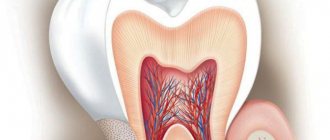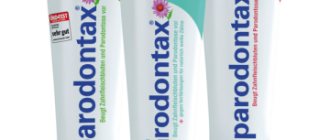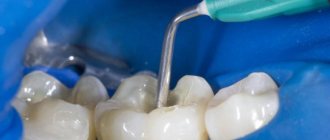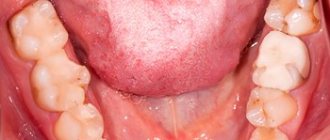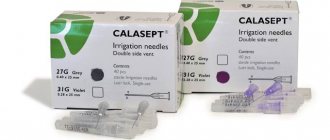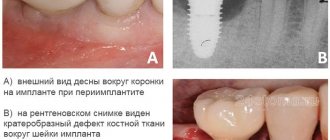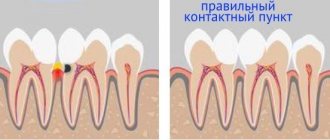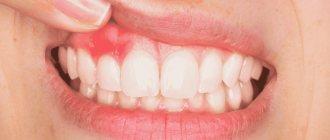Filling is one of the key stages of dental treatment in modern dentistry. It allows you to preserve the natural structure of the tooth, restore chewing function, increase the aesthetic appeal of your smile and prevent the spread of caries.
During the treatment of dental problems, doctors often install temporary fillings. In this article we will tell you why a temporary filling is placed, what functions it performs, what types of temporary fillings there are, and we will also learn a number of interesting facts about professional dental treatment of teeth with the installation of temporary fillings.
What is a temporary filling
A temporary filling is a filling material placed in place of the future location of a permanent filling, in the intermediate period between tooth depulpation and the final closure of the problem area. Typically, it consists of inexpensive materials that can be easily removed from the cavity. The price of a temporary filling is significantly lower than a permanent one, so in many clinics it is installed at a minimal price or free of charge.
Despite the fact that the material used for temporary filling is plastic and does not dissolve in saliva/food liquids, it is not intended for long-term use. The recommended period of wearing most temporary fillings does not exceed several days (in rare cases, fillings of increased strength can be installed, with a service life of up to 4-6 months).
Why are temporary fillings installed?
The main task of a temporary filling is to securely seal the exposed area of the tooth in order to prevent the ingress of water, food, infectious agents, as well as mechanical damage to the tooth structure. In some cases, for example, during root canal treatment, a specialist may use a slow-acting medicine - it must be in the causative location and not interact with other substances.
The most common reasons for installing temporary fillings:
- Diagnosis of complicated caries - involves a preliminary diagnostic opening of the tooth cavity in order to determine the effectiveness of the treatment. Installation is performed only as prescribed by the dentist, if periodic monitoring of the treatment process is necessary. Depending on the materials used, the doctor must inform how long you can walk with a temporary filling and when it will be replaced with a permanent one;
- Treatment of deep caries - installation is carried out after complex treatment of the carious cavity. The drug is first placed in the hole - it should remain at the causative site for several days. This drug allows you to strengthen the tooth tissue located between the open cavity and the pulp chamber;
- Making a crown or orthopedic structure - to prevent infectious agents from entering the prepared cavity. The installation is carried out for several days - until the product is manufactured and installed;
- Periodontitis is an inflammation of the roots of the tooth, which requires treatment with the obligatory opening of the tooth and the application of a medicinal preparation. It reduces the inflammatory process and provides an antiseptic effect. The procedure is carried out similarly to the treatment of deep caries;
- Sanitation of canals is carried out to prevent relapses, especially if there have already been problems in this area. The doctor cleans the canals, fills them with a special medicinal disinfectant solution and closes them with a temporary filling for several days.
Note! Only the attending dentist performing the appointment can give an exact answer as to how long a temporary filling is placed, as well as tell about the exact composition of the temporary filling. Depending on the type of material, the wearing period can vary from several days to 4 months.
"Dentin paste": instructions
Before using the drug, every dentist should read the instructions for use. Temporary material “Dentin paste” should be applied using a special trowel. This is done after the tooth cavity has been prepared. It must be cleaned of carious formations and then thoroughly dried. The paste layer should not exceed 1-2 mm.
The material hardens within 2 hours. During this time, the patient should not take any food. Otherwise, there is a chance that the temporary filling will break.
“Dentin paste” is easily removed from the dental cavity. This will require either a probe or a dental excavator. It is enough to pick up the filling with a smooth lever-like movement, and it will easily come away from the dental tissue.
After applying the paste is completed, you should carefully close the jar with the drug with a lid. This will protect the contents from moisture getting inside. Accordingly, the paste will not harden and will last a long time.
“Dentin paste” is produced in containers of 50 grams. To treat one tooth, no more than 0.5 grams of product is required. Thus, one jar is enough to form approximately 100 temporary fillings.
Types of temporary fillings
In modern dentistry, four main types of temporary fillings are used. They differ in composition, consistency and functionality. Let's take a closer look:
- Artificial dentin is one of the most common and inexpensive filling materials. Provides good stability for 3-7 days, dries quickly in air. In rare cases, the patient may experience a bitter taste in the mouth from the temporary filling;
- Cements (polycarboxylate) are biocompatible cements, used by pediatric dentists, as well as for fixing dentures in adults;
- Dentin paste (oil dentin) is a popular solution based on zinc sulfate with amalgam. It has unique water and pigment-repellent properties that prevent staining of the affected area and the penetration of water into the sealed cavity;
- Vinoxol is a special composition that provides reliable fixation in the cavity of the causative tooth for up to 4-6 months. Used in the treatment of complex dental problems that require systematic monitoring by a dentist. The material has increased disinfecting properties aimed at preventing infection from entering the dental cavity;
- One-component polymers have an increased rate of hardening (under the influence of special light rays). They have an elastic consistency and are easy to use.
The choice of the optimal temporary filling for installation is determined by the attending physician, based on the data of the initial examination, the individual characteristics of the body, as well as the personal preferences of the patient. The doctor also gives recommendations on how much you should not eat after a temporary filling - often this is 2-3 hours. You can drink water half an hour after installation.
Release form
- Paste (jar) -50 g
- Instructions for use - 1 pc.
- Cardboard packaging - 1 pc.
Storage conditions Store in a dry place (relative humidity < 50%) in tightly closed containers at temperatures from +5°C to +25°C. Avoid exposure to moisture, direct sunlight and the presence of heating devices in the immediate vicinity!
Shelf life: 2 years.
Disposal Remains of Dentin Paste material and packaging are safe for the environment and can be classified as household waste and disposed of according to the rules established in a medical institution on the basis of current legislation.
Failure to comply with storage conditions leads to changes in the performance characteristics of the material and a reduction in its shelf life.
How long does a temporary filling last and how is it removed?
The estimated service life of a temporary filling is 3-7 days (in rare cases, when using Vinoxol - 4-6 months). As practice shows, it can last on its own for 2 weeks or even a month, but such periods can have a detrimental effect on the effectiveness of treatment of a dental problem and even harm the teeth, so doctors independently remove the filling at the appointed time.
Removal is carried out by a doctor in a dental office; the removal technique directly depends on the type of material installed. For example, artificial dentin has a fairly low density - this allows removal using a medical spatula and curettes. To remove fillings made of high-strength materials, a drill can be used.
Note! In the first hours after the installation of a temporary filling, painful sensations may occur - this is due to injury to the dental and gum tissues during manipulation. If the pain does not go away within 24 hours, consult a doctor!
Active substances in pastes
To quickly relieve pain, use toothpastes and gels with potassium
, which penetrates the dentinal tubules and anesthetizes the nerve.
And to strengthen the enamel and seal the dentinal tubules, you will need products containing fluoride
,
calcium
or
hydroxyapatite
.
Pastes with fluoride
Fluoride plays an important role for the body and, in particular, teeth.
- Makes bones strong and hard.
- Supports immunity.
- Prevents caries from developing.
The effectiveness of fluoride in preventing caries has been proven by many studies. Choose toothpastes with a fluoride concentration of at least 1000 ppm (preventative pastes) and from 1350 to 1500 ppm (medicinal pastes). The most popular fluoride-containing products are “Ftorlak”, “Fluocal”, “Diplen Denta F” films and Keystone gels. You can learn more about the benefits of fluoride in our article.
Pastes with calcium
An alternative strengthening element to fluoride is calcium. It provides teeth with strength and hardness. Some of the most effective products with it are dental gels GC Tooth Mousse, GC MI Paste Plus and gel for sensitive teeth ROCS Medical Sensitive.
Tooth gel GC Tooth Mousse Strawberry
Tooth gel GC MI Paste Plus Multifruit
Gel for sensitive teeth ROCS (ROCS) Medical Sensitive
Pastes with hydroxyapatite
Hydroxyapatite is a mineral that is the basis of bones and teeth (96% of enamel consists of it). It looks like a white powder. In dentistry, hydroxyapatite is included in dental products as an element that remineralizes and strengthens enamel.
Hydroxyapatite provides:
- decreased enamel sensitivity;
- replenishment of mineral deficiency;
- prevention of caries and its treatment at the white spot stage.
The absolute safety of hydroxyapatate is its main advantage.
The substance can be used in hygiene products even for children and pregnant women. ApaCare Repair restoring dental gel, Biorepair sensitivity reliever, Innova and Biorepair rinses and pastes will help solve the problem of sensitivity.
ApaCare Repair Restoring tooth gel
Biorepair drug for reducing sensitivity and restoring enamel
Suspension Splat Innova Liquid Enamel
INNOVA Intensive strengthening of hypersensitive teeth
Biorepair Mouthwash 500 ml
Toothpaste Biorepair Denti Sensibili PLUS
What to do if a temporary filling falls out or begins to crumble
Given the rather low strength of the materials of temporary fillings, cases of crumbling or falling out of the filling are sometimes observed. This may be due to several factors at once: poor quality/incorrect installation, mechanical injuries or non-compliance with the dentist’s recommendations, including: consumption of rough food.
If your temporary filling falls out, don’t panic! This is certainly an unpleasant, but not a critical moment, which can be corrected by an unscheduled trip to the dental clinic. The doctor will clean the tooth from the remnants of the old filling, re-treat the tooth cavity and install a new temporary filling to continue treatment.
If you or your loved one have dental problems, contact the specialists of the AlfaDent dental clinic in Orenburg and receive qualified help from experienced doctors!
Peculiarities
The main feature of “Dentin paste” is its disinfecting effect. Dentists choose this material for its other characteristics:
- "Dentin paste" is easy to use.
- No mixing is required, the product is already ready for use.
- This is a fairly durable material - it can even be applied for up to 14 days.
- The drug hardens when exposed to moisture. This happens after 2 hours.
- The material hermetically seals the tooth cavity.
- “Dentin paste” does not dissolve over time.
- All the necessary manufacturability is present in this material.
- The drug protects the tooth from staining. This is especially important if filling is done with amalgams.
“Dentin paste” is used to cover the drug, which is placed in the tooth cavity to eliminate the consequences of uncomplicated caries.
